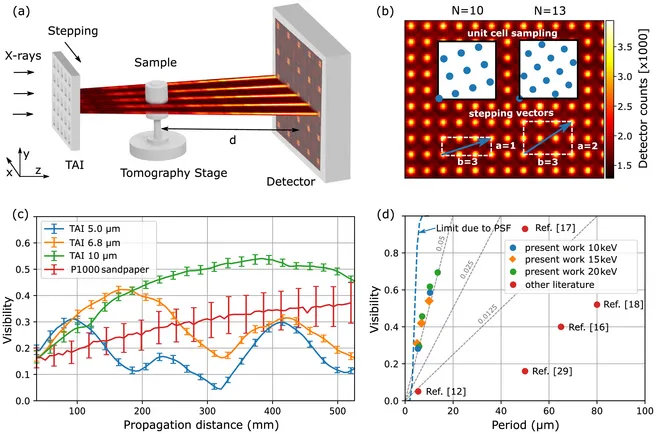Gustschin, A., Riedel, M., Taphorn, K., Petrich, C., Gottwald, W., Noichl, W., Busse, M., Francis, S.E., Beckmann, F., Hammel, J.U. and Moosmann, J., 2021. High-resolution and sensitivity bi-directional x-ray phase contrast imaging using 2d talbot array illuminators. Optica, 8(12), pp.1588-1595 https://doi.org/10.1364/OPTICA.441004
Purpose: Two-dimensional (2D) Talbot array illuminators (TAIs) were designed, fabricated, and evaluated for high-resolution high-contrast x-ray phase imaging of soft tissue at 10–20 keV. The TAIs create intensity modulations with a high compression ratio on the micrometer scale at short propagation distances. Their performance was compared with various other wavefront markers in terms of period, visibility, flux efficiency, and flexibility to be adapted for limited beam coherence and detector resolution. Differential x-ray phase contrast and dark-field imaging were demonstrated with a one-dimensional, linear phase stepping approach yielding 2D phase sensitivity using unified modulated pattern analysis (UMPA) for phase retrieval. The method was employed for x-ray phase computed tomography reaching a resolution of 3 µm on an unstained murine artery. It opens new possibilities for three-dimensional, non-destructive, and quantitative imaging of soft matter such as virtual histology. The phase modulators can also be used for various other x-ray applications such as dynamic phase imaging, super-resolution structured illumination microscopy, or wavefront sensing.
Figure: (a) General setup of the imaging system illustrating the formation of the intensity modulation. (b) Measured intensity pattern with a high compression ratio in the background and illustration of the proposed 1D stepping scheme. The stepping vectors (blue arrows) represent the range and direction of the phase stepping. The sampling of the unit cell is exemplarily shown for both stepping vectors with N=10 and N=13 steps. (c) Distance-dependent visibility and its standard deviation (error bars every four points) for the TAIs and the P1000 diffuser extracted from the Talbot carpet scans at 15 keV. (d) Comparison of the evaluated TAIs in terms of visibility and period with recent literature. The dashed gray lines depict visibility-to-period ratios.
